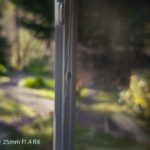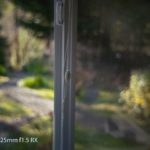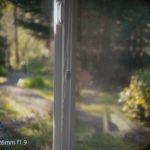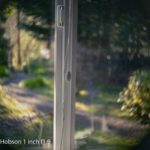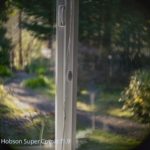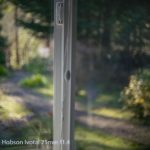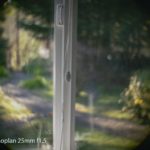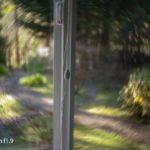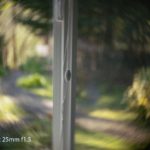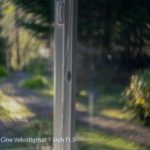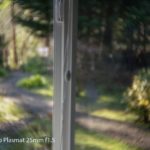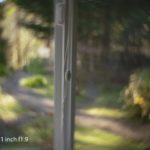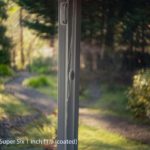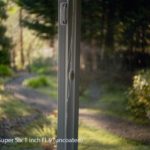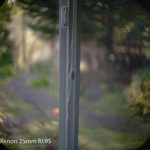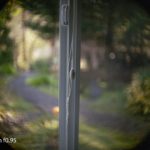The C mount was developed by Bell and Howell for their Filmo movie cameras in the 1920’s and soon became the most common mount for 16mm lenses. Although the diagonal of the 16mm frame is only 12.70mm (and Super 16 is 14.54mm), the 25mm lens became the de facto standard focal length, giving an angle of view approximately that of a 100mm lens on full frame 35mm.
Because of their very short flange distance, these lenses became almost useless with rangefinder and SLR cameras, but have been given a new life in the digital era, since they can be mounted on many mirrorless cameras. Because they were designed to be used on a format that only used the center portion of their nominal image circle, lens makers designed them to have very sharp centers without worrying too much about what happened outside of the format frame. On modern digital cameras, with their much larger formats, the outside parts of image circle are included in the frame, often to very interesting effect.
I somehow managed to gather a bunch of these 25mm (or 1 inch) C mount lenses, and decided to do a comparison to illustrate the (rather wide) differences. Since none of these lenses cover full frame, I shot on APS-C crop. Even then, only a few of these lenses cover the crop frame. I have left the images as shot–no cropping–so that you can see the coverage of the lenses on the APS-C frame.
This is no kind of formal test. I shot a sequence with the camera on a tripod out my window, focused on the window draw string, leaving the background out of focus. All are shot at the maximum of the lens. Even though I shot the sequence quickly, the sun moved appreciably, changing the lighting in the back, and illuminating the window screen on the right side differently from frame to frame. I also adjusted color balances and evened out the exposure somewhat in Photoshop. So these are not exactly as shot, but rather “optimized” to better appreciate the differences in rendering after some minimal post processing.
All these lenses vignette heavily near the edges of the frame. I wanted to demonstrate the full image circle, and so I used Photoshop to minimize the vignetting, also adjusting the shadow values, which affect dark edges much more than the center. Because lightening shadows also does affect dark values in the center, I also did some contrast correction so that the overall images do not appear too washed out. So please understand that these are not as shot, but processed to minimize light falloff at the edges of the image circle and adjust contrast of the whole image.
Please also note that the cheap Chinese adapter I am using has the C mount thread slightly off center, shifting the whole image slightly to the left. I did not notice this until after the test was done. These adapters are cheap, and cheap Chinese adapters are sometimes fine, but then sometimes not.
–Some thoughts on these lenses–
Kern Switar 25mm f1.4 RX – This lens has very unique bokeh. The RX refers to the fact that this lens was corrected for use with the reflex Bolex, with a beam spitting prism in the light path, as opposed to the AR version which was uncorrected. I have seen tests which show some halation due to spherical aberration and corner softness using the RX version as compared to the AR; however it is also true that mirrorless cameras have a glass filter over the sensor, which acts at least partially as the prism in the Bolex did to alter the light path. So it may be that the RX version overcorrects for the effect of glass in the light path, while the AR version undercorrects for it.
Kern Pizar 25mm f1.5 RX – This “Pizar” name designates that it is from a cheaper series of Kern lenses, behind the more expensive Switars; however the Pizar 25mm f1.5 is almost identical with the preceding Switar 25mm f1.4, with the same optical design. I have no idea the marketing idea behind creating an almost identical lens with a different designation. This lens, too, is an RX design, as described above. Looking at the result, we see a very similar rendering, although the out of focus elements are slightly smaller and more defined than with the Switar 1.4.
Kern Pizar 26mm f1.9 – This lens shows less defocus of the background, consistent with its smaller aperture. It also has a slightly smaller image circle than the other two Kern lenses I included. For me quite pleasing and regular bokeh.
Taylor and Hobson 1 inch f1.9 – This is the cheap version of the TH normal lens, branded “Bell & Howell. It has a small image circle, and shows pronounced barrel distortion at the edges producing “swirly” bokeh.
Taylor and Hobson Super Comat 1 inch f1.9 – Though this particular example is only labeled “Bell & Howell”, this is a Taylor-Hobson lens, a deluxe version of the preceding lens. The image circle is very slightly larger, and the rendering, for me, is more pleasing, with a little more definition and structure in out of focus areas, as well as slightly less vignetting at the edges.
Taylor and Hobson Cooke Ivotal Anastigmat 1 inch f1.4 – A very nice fast lens, a classical double gauss design with sharply defined circles of confusion with a thin bright ring, giving a very sculpted-looking “ni sen” (“two line” in Japanese) bokeh. The image circle is considerably larger than with the other two TH lenses, with very even rendering and less falloff at the edges of the circle.
Schneider Xenon 25mm f1.5 – This lens has a small image circle, but the rendering is quite even, without too much distortion except at the very edge of the frame. It is also very sharp in the center.
Meyer-Görlitz Primoplan 25mm f1.5 – This lens has the famous Primoplan bokeh, with elements off center turning more into parabolas than rings. At f1.5 the background is quite defocused. Contrast tends to be a bit low, and the image circle is medium in terms of diameter, without barrel distortion.
Ross Cine 1 inch f1.9 – The Ross is a very quirky lens with some notable features. The first thing one notices is the extreme moustache distortion: about 1/3 out from the center there is exteme foreshortening distortion, with out of focus circles becoming not only ovals, but almost curved lines. This continues out for about another 1/3 of the diameter of the image circle, where suddenly the distortion disappears all the way to the edge. Although this lens is very small in size, it manages to almost fill the APS-C frame at close focusing distances. The lens is also quite sharp in the center. Finally, the out of focus elements are very well defined, giving an almost etched look with sharpening applied. Contrast also tends to be good, even though the lens is uncoated.
Cooke Kinic 1 inch f1.5 – Another very swirly lens, but quite different in character from the Ross above. This lens has more classic barrel distortion swirl, getting very compressed at the edges of the image circle. At f1.5 the background is very defocused, with the bokeh being quite smooth in the center, and gaining some definition in the swirl at the edges. One note about this lens: there are a number of different lens body designs. I have had two, and neither would focus to infinity using any of the C mount to Sony E adapter that I had. It appears that there is a ring at the back of the C mount that keeps the lens from screwing in full on a flat adapter. In one of the two designs that I had, there was no good way to get it to focus to infinity, but in the other, the very back element group could be partially unscrewed inside the mount at the back of the lens, allowing for infinity focus. In the other one, the rear element group was only held in place by a retaining ring, and unscrewing that allowed the rear element to rattle around loose.
Wollensak Cine Velostigmat 1 inch f1.5 – For me this lens is a true “sleeper”. These lenses are fairly common, and are perhaps the least expensive of the fast 1 inch (25mm) lenses. There is a lot to recommend it. First, it has an extremely large image circle, covering the APS-C frame at close focusing distances (albeit with a lot of falloff at the edges which has to be corrected). It also has strong swirl, with well-defined, lined bokeh. On the downside, it does tend to flare easily, with highlight bloom.There are both uncoated and coated versions; obviously the latter is more desirable, especially shooting against the light.
Hugo Meyer Kino Plasmat 25mm f1.5 – The Kino Plasmat is expensive, but there is a lot to recommend it. This is another lens that has a very large image circle–perhaps the largest of any of the lenses of this type I have used. It will completely cover the APS-C frame at close focus distances. It is another very swirly lens, in some ways quite similar to the Wollensak above, but the bokeh is strikingly well-defined, even near the center, with the edges taking on an almost surreal quality of sharp but distorted definition, even when far behind the focus plane. However it costs a three or four (or even more) times what the Wollensak costs, and the Wollensak comes close for look.
Dallmeyer 1 inch f1.9 – This lens I find quite lovely. Although f1.9, the background seems more out of focus than with other lenses of similar maximum aperture. The image circle is quite large, although it doesn’t cover the APS-C frame. It has a far amount of barrel distortion creating swirl, which increases smoothly toward the edge of the image circle. The bokeh is not too “spiky” but has, for me, a lot of character, and the center is very sharp.
Dallmeyer Super-Six Anastigmat 1 inch f1.9 (Dallcoated) – The Dallmeyer Super-Sixes are legendary lenses, and in this smallest of the series, we can see some of the reasons. First, the lens has very wide coverage, even though only a classical double gauss design. Normally speaking, double gauss lenses have an image circle commensurate with their focal length, but here we see that the image circle covers the APS-C sensor, considerably larger than 25mm. (Note: the darkening of the corners here are caused by vignetting due to a built in lens hood on this particular lens). What is noteworth here is the lack of distortion: while there is some barrel distortion and a bit of swirl at the extreme edges, there is much less than with any other 25mm C mount lens of this coverage that I know of. Second, we have the famous Super-Six bokeh–very edgy, with bright, thin rings at the edge of the circles of confusion. It is interesting to compare the bokeh and definition in the background here, compared to the preceding Dallmeyer 1.9. The lens is also quite sharp wide open, though there is a tendency for the highlights to bloom, which seems characteristic of the Super-Sixes I have tried. A great lens, but unfortunately very expensive.
Dallmeyer Super-Six Anastigmat 25mm f1.9 (uncoated) – Here is a second example of the 1 inch Super-Six, this one uncoated. I had expected the coated version to be a bit more saturated or contrastier, but in fact that are nearly the same in those respects, except when shooting into a bright light source, where the uncoated one shows some lens flares that are much less prominent on the coated version. This one has no lens hood and you can see that there is no corner vignetting, truly a feat for a lens of this focal length.
Schneider Xenon f0.95 – A very fast lens that is also decently sharp. The bokeh is quite soft in the center, but at the edges it show an interesting effect, where what should be circles become almost half-moons. Barrel distortion is quite low–this is not a swirly lens, and the image circle is quite small, I’m sure because the designers needed to reduce the image circle as much as possible to concentrate what light is collected by the lens just where it is needed.
JML T.V. lens 25mm f0.95 – JML Optical is primarily focused on industry, and this lens was most probably made for some sort of CCTV application, rather than for consumer cameras. In fact the C mount is used in quite a number of machine and industrial applications. The Schneider Xenon above is also a modern lens, and since no one is really making C mount lenses for movie cameras anymore, it too was designed for industrial applications, although the original was, I believe, designed for movie cameras. In any case, this lens also exhibits the same kind of half-moon bokeh at the edges, but the bokeh is the center is less soft, with more definition than the Schneider. The image circle is slightly smaller and it appears to be slightly longer than the Xenon. Interestingly, it is significantly sharper in the center that that lens, and in fact, sharper than any other lens in this test in the center at maximum aperture, rivaling other lenses’ sharpness and lack of aberration even around f2.0. But then, it is probably the most modern design. These do come to the market occasionally, and if you are in the market for an ultra-fast 25mm C mount lens and can live with the small image circle, I do recommend this one over the Schneider or the Angenieux 25mm f0.95, which I had for a time.
